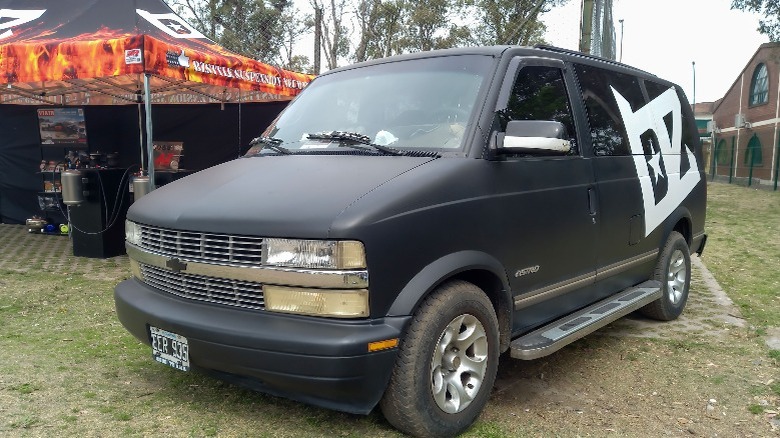Everything To Know About Chevrolet's 4.3L V6 Engine
When it comes to GM engines, the Chevy small block and LS motors get most of the love and attention. But there's another Chevy engine deserving of recognition for its legacy in the world of GM trucks. The Chevrolet 4.3L V6 first hit the market in 1985 and served as the foundation for GM's small truck and SUV lineups for the next 30 years. Throughout the decades that followed its inception, the Chevy 4.3L V6 — also called the Vortec 4.3 or Vortec 4300 — saw a series of changes to improve power output and efficiency and address modern advancements like fuel injection and emissions control devices. During those years, the Vortec 4.3 developed a reputation for reliability and modest power.
Although it has since been replaced in the GM lineup, the Vortec 4300 lives on as a stock engine in thousands of small GM pickups and SUVs. It's also a favored option for custom builds and engine swaps and is an especially popular choice for custom Jeep builds. From birth to retirement and everything in between, here's what you need to know about Chevrolet's 4.3L V6 engine.
The history of Chevy's Vortec 4.3L V6 engine
In 1978, Chevrolet released the 90-degree V6 engine as a scaled-down version of its small block V8. At 200 cubic inches of displacement (CID) or 3.3 liters, this V6 was nearly identical to the iconic Chevy small block V8. It featured a similar block design and much of the same hardware, including motor mounts. The 90-degree V6 displacement increased to 229 CID over the next few years before settling into its final form of 4.3 liters and 262 CID in 1985.
As a younger sibling to the small block V8, the Vortec 4.3 featured the same cylinder bore and stroke as the famous 350. That means the V6 could use many of the same components as the bigger motor, including pistons, main and camshaft bearings, timing cover, oil pump, and valvetrain components. The 4.3L V6 motor was the first to be called a Vortec engine. At this time, Chevy was developing its vortex technology, a proprietary method of mixing air and fuel in the combustion chamber. The 4.3L V6 became the first and longest-lasting of the Vortec lineup.
In the years that followed, the Vortec 4.3 saw several changes. Upon its release, the 4.3L V6 was available as a carburated motor capable of 155 horsepower and 230 lb-ft of torque. A throttle body fuel-injected version capable of 130 horsepower was also available in some large cars, like the Monte Carlo coupe and the Pontiac Grand Prix. But the Vortec 4300 evolved quickly. Over the next few years, several small changes — including a balance shaft to reduce unwanted shaking, multi-port fuel injection, and full OBDII compliance — transformed the 4.3L V6 into a modern engine capable of a modest 195 to 200 horsepower.
Common problems with the Vortec 4.3
The Vortec 4.3 has a reputation for being a reliable, solid engine. But that doesn't mean it's free of flaws. While the engine block and most internals tend to be extremely sound and dependable, the Vortec 4300 has some known issues with some components. The most common problem with the Vortec 4.3 involves the idle control valve (ICV) and throttle position sensor (TPS). Both components mount to the throttle body and help control airflow, and both are prone to clogging and degradation over time. A faulty ICV or TPS can cause symptoms like rough idling and reduced power output. Luckily, the fix for this issue is relatively simple — clean or replace the sensors.
Outside of faulty ICV and TPS sensors, a few other problems plague the Vortec 4300. Worn-out intake manifold gaskets are a common issue for this engine and can cause vacuum and coolant leaks. The fix is pretty straightforward and only involves replacing the gasket. The Vortec 4.3 also has issues with its plastic distributor cap. Over time and due to engine heat, the plastic cap can warp. This allows dirt, moisture, and other contaminants to enter the cap, resulting in corrosion that can lead to engine misfires. This problem is also easy to fix by replacing the faulty cap with a metal version. Other common issues with the Vortec 4300 include faulty spider injectors, excessive oil consumption due to a malfunctioning active fuel management (AFM) system, and carbon buildup. Again, these are relatively minor issues. Drivers can repair faulty spider injectors using a rebuild kit, solve the excess oil consumption problem by turning off the AFM system, and remove carbon buildup with a specialized cleaning solution.
The 4.3L V6 in the modern era
GM produced the Vortec 4.3 from 1985 to 2014, when it was replaced by a modern 4.3L V6 engine —- the EcoTec3 LV3. Chevy's 4.3L V6 EcoTec3 LV3 takes its inspiration from the Vortec 4300, but it is a distinct motor and not a new iteration of the old Vortec. The LV3 features a series of improvements over the Vortec 4300, including an aluminum block, variable valve timing, and direct fuel injection. These updates allow the modern engine to produce greater power and torque and improve its idle stability.
The LV3 can deliver up to 285 horsepower and 305 lb-ft of torque, significantly enhancing its towing capabilities. The LV3 was the base motor for 1500-level GM and Chevy pickups between 2014 and 2021 when it was phased out in favor of a turbocharged four-cylinder, a three-liter inline six-cylinder, and a couple of V8s. Another version of the LV3 — the LV1 — is still in production and is the base motor for the Chevrolet Express and the GMC Savana.
As for the old Vortec 4.3, it lives on as a beloved swap option for enthusiasts in various niches. Many companies produce aftermarket modifications for the Vortec 4300, making it an accessible project motor for DIYers and experienced engine builders alike. From grassroots drag racers to drivers looking to install a more modern engine in a vintage truck or SUV, the Vortec 4.3 represents a solid choice backed up by decades of reliability.



